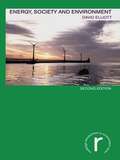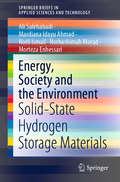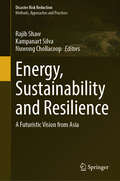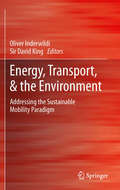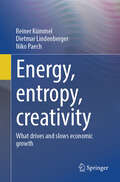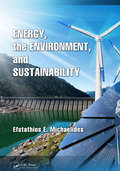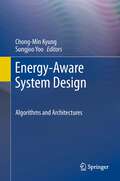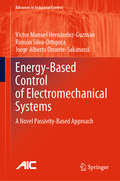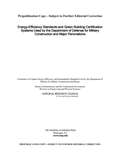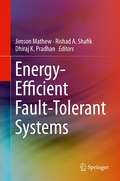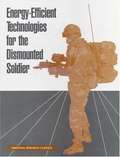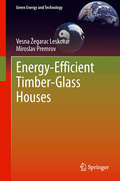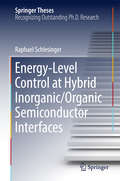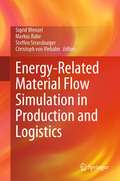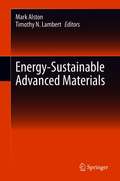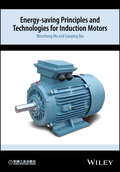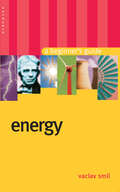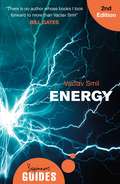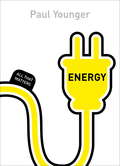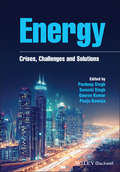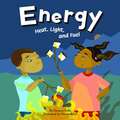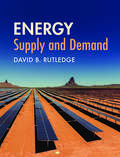- Table View
- List View
Energy, Society and Environment (Routledge Introductions to Environment: Environment and Society Texts)
by David ElliottSociety's use of energy and technology is at heart of many of the most significant environmental problems of recent years, including problems of health, global warming and acid rain. Use of technology has been a major cause of environmental problems but new technology offers many solutions.Energy, Society and Environment is an introduction to energy and energy use, and the interactions between technology, society and the environment. The book is clearly structured to examine:* key environmental issues, and the harmful impacts of energy use* new technological solutions to environmental problems* implementation of possible solutions* implications for society in developing a sustainable approach to energy use.Social processes and strategic solutions to problems are located within a clear, technological context with topical case studies and informative diagrams illustrating key issues.Energy, Society and Environment examines the potential and limits of technical solutions to environmental problems and suggests the social, economic and political changes necessary to avoid serious environmental damage in the future.
Energy, Society and the Environment: Solid-State Hydrogen Storage Materials (SpringerBriefs in Applied Sciences and Technology)
by Mardiana Idayu Ahmad Ali Salehabadi Norli Ismail Norhashimah Morad Morteza EnhessariThis book provides a comprehensive and contemporary overview of advances in energy and energy storage technologies. Although the coverage is varied and diverse, the book also addresses unifying patterns and trends in order to enrich readers’ understanding of energy and energy storage systems, particularly hydrogen energy storage, including e.g. their morphology, porosity and material structure. Readers will also gain insights into the hydrogen storage performance landscape, based on data released by the US Department of Energy (DOE), providing a basis for understanding real-world applications. The book also discusses the superior hydrogen storage performance of solid-state materials and explores the physical and chemical properties that can potentially affect their performance.
Energy, Sustainability and Resilience: A Futuristic Vision from Asia (Disaster Risk Reduction)
by Rajib Shaw Kampanart Silva Nuwong ChollacoopThis book analyzes the experiences of energy, sustainability and resilience issues from different Asian countries and puts forward a futuristic vision of an energy sector for sustained development. Energy is at the core of development, but in energy generation, there are severe environmental implications in many cases. This clearly affects development and causes significant challenges to sustainability. Climate change and disasters have an effect on energy infrastructures and also make significant impacts on humans in terms of both shocks and stresses. Therefore, it is extremely important to understand the linkage of energy, sustainability and resilience. Asia is a hotspot of climate change and disasters, suffering from severe damages to the energy infrastructure of the countries there. At the same time, being a core of world development trajectories, Asia produces and consumes more energy in different sectors than any other part of the world. Also, however, Asia serves as a core region of innovative ideas in energy and related sectors.
Energy, Transport, & the Environment
by Oliver Inderwildi Sir David KingSustainable mobility is a highly complex problem as it is affected by the interactions between socio-economic, environmental, technological and political issues. Energy, Transport, & the Environment: Addressing the Sustainable Mobility Paradigm brings together leading figures from business, academia and governments to address the challenges and opportunities involved in working towards sustainable mobility. Key thinkers and decision makers approach topics and debates including: energy security and resource scarcity greenhouse gas and pollutant emissions urban planning, transport systems and their management governance and finance of transformation ·the threats of terrorism and climate change to our transport systems. Introduced by a preface from U.S. Secretary of Energy, Steven Chu and an outline by the editors, Dr Oliver Inderwildi and Sir David King, Energy, Transport, & the Environment is divided into six sections. These sections address and explore the challenges and opportunities for energy supply, road transport, urban mobility, aviation, sea and rail, as well as finance and economics in transport. Possible solutions, ranging from alternative fuels to advanced urban planning and policy levers, will be examined in order to deepen the understanding of currently proposed solutions within the political realities of the dominating economic areas. The result of this detailed investigation is an integrated view of sustainable transport for both people and freight, making Energy, Transport, & the Environment key reading for researchers, decision makers and policy experts across the public and private sectors.
Energy, Transport, & the Environment: Addressing the Sustainable Mobility Paradigm
by Oliver Inderwildi Sir David KingSustainable mobility is a highly complex problem as it is affected by the interactions between socio-economic, environmental, technological and political issues. Energy, Transport, & the Environment: Addressing the Sustainable Mobility Paradigm brings together leading figures from business, academia and governments to address the challenges and opportunities involved in working towards sustainable mobility. Key thinkers and decision makers approach topics and debates including: energy security and resource scarcity greenhouse gas and pollutant emissions urban planning, transport systems and their management governance and finance of transformation·the threats of terrorism and climate change to our transport systems. Introduced by a preface from U.S. Secretary of Energy, Steven Chu and an outline by the editors, Dr Oliver Inderwildi and Sir David King, Energy, Transport, & the Environment is divided into six sections. These sections address and explore the challenges and opportunities for energy supply, road transport, urban mobility, aviation, sea and rail, as well as finance and economics in transport. Possible solutions, ranging from alternative fuels to advanced urban planning and policy levers, will be examined in order to deepen the understanding of currently proposed solutions within the political realities of the dominating economic areas. The result of this detailed investigation is an integrated view of sustainable transport for both people and freight, making Energy, Transport, & the Environment key reading for researchers, decision makers and policy experts across the public and private sectors.
Energy, entropy, creativity: What drives and slows economic growth
by Reiner Kümmel Dietmar Lindenberger Niko PaechThis book helps to understand the importance of thermodynamics for economics, the environment and society. It argues for the integration of the first two laws of thermodynamics into textbook economics. In doing so, systemic similarities in thermodynamics and the theory of economic growth lead to the use of similar mathematical methods that allow industrial economies to be described realistically. From this, the authors propose tools for solving social and environmental problems. The book is aimed at all those interested in interdisciplinary research on the development problems of the economy and society and who want to understand what drives their upheavals. The authors of the book have been dealing with these development problems for a long time: the theoretical physicist Reiner Kümmel from the University of Würzburg, the physicist and economist Dietmar Lindenberger from the University of Cologne and the Energy Economics Institute at this university, and the economist Niko Paech from the University of Siegen. "It is my pleasure to recommend this book to readers. It is driven by the idea of exploring the physical limits of human economic activity using thermodynamics, one of the most universal physical theories we have." Comment on the original German edition by Dieter Meschede, Professor of Physics, University of Bonn
Energy, the Environment, and Sustainability (Mechanical and Aerospace Engineering)
by Efstathios E. MichaelidesEnergy and the Environment explains in simple terms what the energy demand is at the present, what the environmental effects of energy use are, and what can be accomplished to alleviate the environmental effects of energy use and ensure adequate energy supply. Though technical in approach, the text uses simple explanations of engineering processes and systems and algebra-based math to be comprehensible to students in a range of disciplines. Schematic diagrams, quantitative examples, and numerous problems will help students make quantitative calculations. This will assist them in comprehending the complexity of the energy-environment balance, and to analyze and evaluate proposed solutions.
Energy-Aware System Design
by Chong-Min Kyung Sungjoo YooPower consumption becomes the most important design goal in a wide range of electronic systems. There are two driving forces towards this trend: continuing device scaling and ever increasing demand of higher computing power. First, device scaling continues to satisfy Moore's law via a conventional way of scaling (More Moore) and a new way of exploiting the vertical integration (More than Moore). Second, mobile and IT convergence requires more computing power on the silicon chip than ever. Cell phones are now evolving towards mobile PC. PCs and data centers are becoming commodities in house and a must in industry. Both supply enabled by device scaling and demand triggered by the convergence trend realize more computation on chip (via multi-core, integration of diverse functionalities on mobile SoCs, etc.) and finally more power consumption incurring power-related issues and constraints. Energy-Aware System Design: Algorithms and Architectures provides state-of-the-art ideas for low power design methods from circuit, architecture to software level and offers design case studies in three fast growing areas of mobile storage, biomedical and security. Important topics and features: - Describes very recent advanced issues and methods for energy-aware design at each design level from circuit and architecture to algorithm level, and also covering important blocks including low power main memory subsystem and on-chip network at architecture level - Explains efficient power conversion and delivery which is becoming important as heterogeneous power sources are adopted for digital and non-digital parts - Investigates 3D die stacking emphasizing temperature awareness for better perspective on energy efficiency - Presents three practical energy-aware design case studies; novel storage device (e.g., solid state disk), biomedical electronics (e.g., cochlear and retina implants), and wireless surveillance camera systems. Researchers and engineers in the field of hardware and software design will find this book an excellent starting point to catch up with the state-of-the-art ideas of low power design.
Energy-Based Control of Electromechanical Systems: A Novel Passivity-Based Approach (Advances in Industrial Control)
by Ramón Silva-Ortigoza Victor Manuel Hernández-Guzmán Jorge Alberto Orrante-SakanassiThis book introduces a passivity-based approach which simplifies the controller design task for AC-motors. It presents the application of this novel approach to several classes of AC motors, magnetic levitation systems, microelectromechanical systems (MEMS) and rigid robot manipulators actuated by AC motors. The novel passivity-based approach exploits the fact that the natural energy exchange existing between the mechanical and the electrical subsystems allows the natural cancellation of several high order terms during the stability analysis. This allows the authors to present some of the simplest controllers proposed in scientific literature, but provided with formal stability proofs. These simple control laws will be of use to practitioners as they are robust with respect to numerical errors and noise amplification, and are provided with tuning guidelines. Energy-based Control of Electromechanical Systems is intended for both theorists and practitioners. Therefore, the stability proofs are not based on abstract mathematical ideas but Lyapunov stability theory. Several interpretations of the proofs are given along the body of the book using simple energy ideas and the complete proofs are included in appendices. The complete modeling of each motor studied is also presented, allowing for a thorough understanding.Advances in Industrial Control reports and encourages the transfer of technology in control engineering. The rapid development of control technology has an impact on all areas of the control discipline. The series offers an opportunity for researchers to present an extended exposition of new work in all aspects of industrial control.
Energy-Efficiency Standards and Green Building Certification Systems Used by the Department of Defense for Military Construction and Major Renovations
by National Research Council Division on Engineering and Physical Sciences Board on Infrastructure and the Constructed Environment Committee to Evaluate Energy-Efficiency and Sustainability Standards Used by the Department of Defense for Military Construction and RepairCongress has an ongoing interest in ensuring that the 500,000 buildings and other structures owned and operated by the Department of Defense (DOD) are operated effectively in terms of cost and resource use. Section 2830 of the National Defense Authorization Act for fiscal year requires the Secretary of Defense to submit a report to the congressional defense committees on the energy-efficiency and sustainability standards used by DOD for military construction and major renovations of buildings. DOD's report must include a cost-benefit analysis, return on investment, and long-term payback for the building standards and green building certification systems, including: (A) American Society of Heating, Refrigerating and Air-Conditioning Engineers (ASHRAE) Standard 189.1-2011 for the Design of High-Performance, Green Buildings Except Low-Rise Residential. (B) ASHRAE Energy Standard 90.1-2010 for Buildings Except Low-Rise Residential. (C) Leadership in Energy and Environmental Design (LEED) Silver, Gold, and Platinum certification for green buildings, as well as the LEED Volume certification. (D) Other American National Standards Institute (ANSI) accredited standards. DOD's report to the congressional defense committees must also include a copy of DOD policy prescribing a comprehensive strategy for the pursuit of design and building standards across the department that include specific energy-efficiency standards and sustainable design attributes for military construction based on the cost-benefit analysis, return on investment, and demonstrated payback required for the aforementioned building standards and green building certification systems. Energy-Efficiency Standards and Green Building Certification Systems Used by the Department of Defense for Military Construction and Major Renovations summarizes the recommendations for energy efficiency.
Energy-Efficient Fault-Tolerant Systems
by Dhiraj K. Pradhan Rishad A. Shafik Jimson MathewThis book describes the state-of-the-art in energy efficient, fault-tolerant embedded systems. It covers the entire product lifecycle of electronic systems design, analysis and testing and includes discussion of both circuit and system-level approaches. Readers will be enabled to meet the conflicting design objectives of energy efficiency and fault-tolerance for reliability, given the up-to-date techniques presented.
Energy-Efficient Technologies for the Dismounted Soldier
by Committee on Electric Power for the Dismounted SoldierThis book documents electric power requirements for the dismounted soldier on future Army battlefields, describes advanced energy concepts, and provides an integrated assessment of technologies likely to affect limitations and needs in the future. It surveys technologies associated with both supply and demand, including energy sources and systems; low-power electronics and design; communications, computers, displays, and sensors; and networks, protocols, and operations. The advanced concepts discussed are predicated on continued development by the Army of soldier systems similar to the Land Warrior system on which the committee based its projections on energy use.
Energy-Efficient Timber-Glass Houses
by Vesna Žegarac Leskovar Miroslav PremrovThe book discusses combining timber and glass, two eco materials, with a view to developing an optimal contemporary energy-efficient house with an attractive design. Furthermore, the book connects an architectural design approach with structural research to show the possibilities of stabilizing the building with an increased size of the glazing. Research results where the glazing is considered as a load-bearing structural element are therefore presented in a manner leading to the development of an optimal model of the timber-glass house, considering both the structural and energy related aspects. The presented research work can be useful to designers and future experts in their planning of optimal energy-efficient timber buildings. The study is based on using timber and glass, which were previously neglected as construction materials. With suitable technological development and appropriate use, they are nowadays becoming essential construction materials as far as energy efficiency is concerned. However, their combined use is extremely complicated, from both the constructional point of view as well as from that of energy efficiency and sets multiple traps for designers. A good knowledge of their advantages and drawbacks is thus vitally important, which is shown in the present monograph. Energy-efficient timber-glass houses was selected by the Slovenian National Research Agency as an extraordinary scientific achievement in the field of technical sciences/civil engineering for the year 2013.
Energy-Level Control at Hybrid Inorganic/Organic Semiconductor Interfaces
by Raphael SchlesingerThis work investigates the energy-level alignment of hybrid inorganic/organic systems (HIOS) comprising ZnO as the major inorganic semiconductor. In addition to offering essential insights, the thesis demonstrates HIOS energy-level alignment tuning within an unprecedented energy range. (Sub)monolayers of organic molecular donors and acceptors are introduced as an interlayer to modify HIOS interface-energy levels. By studying numerous HIOS with varying properties, the author derives generally valid systematic insights into the fundamental processes at work. In addition to molecular pinning levels, he identifies adsorption-induced band bending and gap-state density of states as playing a crucial role in the interlayer-modified energy-level alignment, thus laying the foundation for rationally controlling HIOS interface electronic properties. The thesis also presents quantitative descriptions of many aspects of the processes, opening the door for innovative HIOS interfaces and for future applications of ZnO in electronic devices.
Energy-Related Material Flow Simulation in Production and Logistics
by Markus Rabe Sigrid Wenzel Steffen Strassburger Christoph Von ViebahnThis book provides for the first time an overview on the current approaches and applications of energy aspects in production and logistics by the use of simulation techniques. During the last decade, the importance of energy in the material flow processes has become more and more important. The pressure to reduce the environmental footprint of production and logistics systems will even intensify in future. Therefore, enterprises have started to integrate the use of energy into their planning processes much more than before, even designing feedback loops, e.g., from energy control to production control. This receives additional attention with the increasing use of renewable, but less reliable, energy sources. Care must be taken to establish processes that aim to use energy when it is available. As an example, many industrial processes like melting or coating have significant energy demands, but could vary the point of time of its consumption within specific limits, leading to a very high complexity. It discusses the construction and application of energy-specific performance indicators and analyzes the input information that needs to be acquired before implementing suitable models. On this basis, concrete technical solutions are introduced.
Energy-Sustainable Advanced Materials
by Mark Alston Timothy N. LambertThis book highlights progress towards the capture, storage, and utilization of energy through the development of advanced materials and systems based on abundant elements, materials, and commodities. Energy is critical to human sustainability and a global-scale deployment of renewable energy systems will be required. Hence, the chapters integrate the fundamental aspects that enable the technical advancements in detail, along with an emphasis on the need for highly sustainable materials to enable real impact for humankind: To determine innovation of energy capture and storage through characterizations of materials in areas of electrical generation and electrical storage systems; To demonstrate better performance, economic and environmental advantages than the current state of the art; To define new chemistries and materials for innovations in energy density design through lower operational temperatures, improve safety, expanding operational voltage, battery durability lifetimes, and reduce system costs. Advances critical technical and commercial objectives for novel high energy density materials;Evaluates operational material models for optimizing energy capture that are integrated by configurations as a system; Illustrates utilization of material life cycle assessment for high energy outputs generators for sustainable materials.
Energy-saving Principles and Technologies for Induction Motors
by Wenzhong Ma Lianping BaiA unique guide to the integration of three-phase induction motors with the emphasis on conserving energy • The energy-saving principle and technology for induction motor is a new topic, and there are few books currently available; this book provides a guide to the technology and aims to bringabout significant advancement in research, and play an important role in improving the level of motor energy saving• Includes new and innovative topics such as a case study of energy saving in beam pumping system, and reactive compensation as a means of energy saving• The authors have worked in this area for 20 years and this book is the result of their accumulated research and expertise. It is unique in its integration of three-phase induction motors with the emphasis on conserving energy• Integrates the saving-energy principle, technology, and method of induction motors with on-site experiences, showing readers how to meet the practical needs and to apply the theory into practice. It also provides case studies and analysis which can help solve problems on-site
Energy: A Beginner's Guide
by Vaclav SmilIn this user-friendly and informative book, prolific author and academic Vaclav Smil provides an introduction to this far-reaching term and gives the reader a greater understanding of energy's place in both past and present society. Starting with an explanation of the concept, he goes on to cover such exciting topics as the inner workings of the human body, and the race for more efficient and environmentally friendly fuels. Whether you're after insight or dinner table conversation, Energy: A Beginner's Guide will amaze and inform, uncovering the science behind one of the most important concepts in our universe.<P><P> Chosen for Mark Zuckerberg's "A Year of Books"
Energy: A Beginner's Guide (Beginner's Guides)
by Vaclav SmilWith one famous equation, E=mc2, Einstein proved all matter can be described as energy. It is everywhere and it is everything. In this newly updated and engaging introduction, renowned scientist Vaclav Smil explores energy in all its facets – from the inner workings of the human body to what we eat, the car we drive and the race for more efficient and eco-friendly fuels. Energy: A Beginner's Guide highlights the importance of energy in both past and present societies, by shedding light on the science behind global warming and efforts to prevent it, and by revealing how our daily decisions affect energy consumption. Whether you're looking for dinner table conversation or to further your own understanding, this book will amaze and inform, uncovering the truths and exposing the myths behind one of the most important concepts in our universe.
Energy: All That Matters
by Paul L. YoungerEnergy is probably the defining topic of our age. Uncertainty over the long-term availability of some hydrocarbons and nuclear fuels are increasingly prompting volatility in energy prices on world markets. Meanwhile, no serious scientist doubts that the unabated atmospheric emissions of carbon dioxide associated with traditional forms of energy use are (at very least) exacerbating natural variations in climate in undesirable ways. For either reason or both, few commentators of any stature argue that "do nothing" is a credible option in the world of energy management. The technical challenges are legion; yet energy is just as much a socio-economic issue. Surprisingly, there are no authoritative books giving an overall introduction to energy for a general readership, offering adequate coverage of the scientific, engineering, environmental, social and economic dimensions in a single, reasonably-sized and easily-readable volume. The book proposed here seeks to fill that gap.
Energy: All That Matters (All That Matters)
by Professor Paul L YoungerEnergy is probably the defining topic of our age. Uncertainty over the long-term availability of some hydrocarbons and nuclear fuels are increasingly prompting volatility in energy prices on world markets. Meanwhile, no serious scientist doubts that the unabated atmospheric emissions of carbon dioxide associated with traditional forms of energy use are (at very least) exacerbating natural variations in climate in undesirable ways. For either reason or both, few commentators of any stature argue that "do nothing" is a credible option in the world of energy management. The technical challenges are legion; yet energy is just as much a socio-economic issue. Surprisingly, there are no authoritative books giving an overall introduction to energy for general readers, students, engineers, geographers or architects, offering adequate coverage of the scientific, engineering, environmental, social and economic dimensions in a single, reasonably-sized and easily-readable volume. The book proposed here seeks to fill that gap.All That Matters about energy. All That Matters books are a fast way to get right to the heart of key issues.
Energy: Crises, Challenges and Solutions
by Gaurav Kumar Pardeep Singh Suruchi Singh Pooja BawejaEnergy Global energy demand has more than doubled since 1970. The use of energy is strongly related to almost every conceivable aspect of development: wealth, health, nutrition, water, infrastructure, education and even life expectancy itself are strongly and significantly related to the consumption of energy per capita. Many development indicators are strongly related to per-capita energy consumption. Fossil fuel is the most conventional source of energy but also increases greenhouse gas emissions. The economic development of many countries has come at the cost of the environment. However, it should not be presumed that a reconciliation of the two is not possible.The nexus concept is the interconnection between the resource energy, water, food, land, and climate. Such interconnections enable us to address trade-offs and seek synergies among them. Energy, water, food, land, and climate are essential resources of our natural environment and support our quality of life. Competition between these resources is increasing globally and is exacerbated by climate change. Improving resilience and securing resource availability would require improving resource efficiency. Many policies and programs are announced nationally and internationally for replacing the conventional mode and also emphasizing on conservation of fossil fuels and reuse of exhausted energy, so a gap in implications and outcomes can be broadly traced by comparing the data.This book aims to highlight problems and solutions related to conventional energy utilization, formation, and multitudes of ecological impacts and tools for the conservation of fossil fuels. The book also discusses modern energy services as one of the sustainable development goals and how the pressure on resource energy disturbs the natural flows. The recent advances in alternative energy sources and their possible future growth are discussed and on how conventional energy leads to greenhouse gas formation, which reduces energy use efficiency. The different policies and models operating is also addressed, and the gaps that remained between them. Climate change poses a challenge for renewable energy, and thus it is essential to identify the factors that would reduce the possibility of relying on sustainable energy sources.This book will be of interest to researchers and stakeholders, students, industries, NGOs, and governmental agencies directly or indirectly associated with energy research.
Energy: Heat, Light, and Fuel
by Darlene R. Stille Sheree BoydThe forms of energy discussed include chemical energy, kinetic energy, and solar energy.
Energy: Supply and Demand
by David B. RutledgeFocusing on trends in energy supply and demand, this text provides students with a comprehensive account of the subject and an understanding of how to use data analysis and modeling to make future projections and study climate impacts. Developments in technology and policy are discussed in depth, including the role of coal, the fracking revolutions for oil and gas, the electricity grid, wind and solar power, battery storage, and biofuels. Trends in demand are also detailed, with analysis of industrial demands such as LEDs, air conditioning, heat pumps, and information technology, and the transportation demands of railroads, ships, and cars (including electric vehicles). The environmental impacts of the energy industry are considered throughout, and a full chapter is dedicated to climate change. Real-life case studies and examples add context, and over 400 full-color figures illustrate key concepts. Accompanied by a package of online resources including solutions, video examples, sample data, and PowerPoint slides, this is an ideal text for courses on energy and is accessible to a range of students from engineering and related disciplines.

